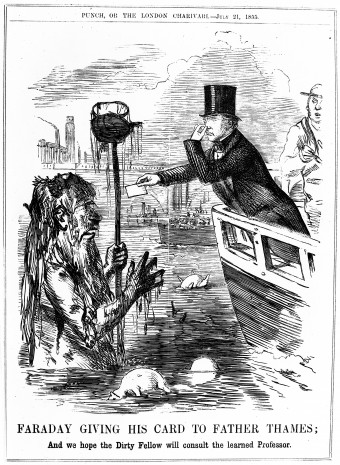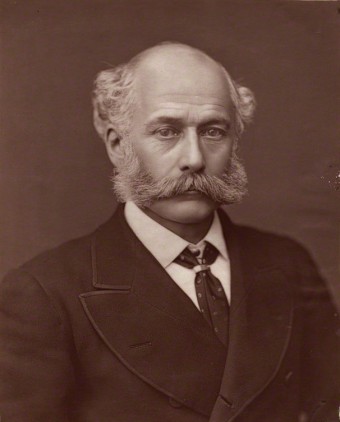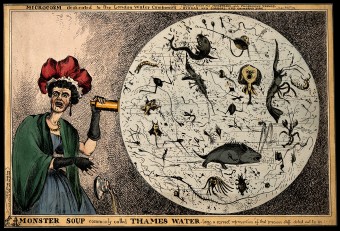The Great Stink of 1858
 According to the only book I currently have on my desk, everyone poops and that’s okay. What’s less okay though is when there’s nowhere for that poop to go- something people in Victorian era London found out first hand when all of the sewage they’d pumped into the Thames dried up and caused a stench that spurred London’s City Press to note- “Gentility of speech is at an end—it stinks, and whoso once inhales the stink can never forget it and can count himself lucky if he lives to remember it.”
According to the only book I currently have on my desk, everyone poops and that’s okay. What’s less okay though is when there’s nowhere for that poop to go- something people in Victorian era London found out first hand when all of the sewage they’d pumped into the Thames dried up and caused a stench that spurred London’s City Press to note- “Gentility of speech is at an end—it stinks, and whoso once inhales the stink can never forget it and can count himself lucky if he lives to remember it.”
To begin with, let’s talk a little about the Thames, or more specifically, all of the stuff Victorian Londoners dumped into it. While the tons of raw, unfiltered sewage was probably the most noticeable thing being pumped into the river, the Thames was also where waste water from breweries and paper mills, refuse from slaughterhouses, and tons of ordinary household waste ended up being unceremoniously dumped.
If you’re wondering why Londoners had been so short-sighted as to think dumping tons of excrement and refuse into a river that also provided much of their drinking water was a good idea, it was generally thought that since the Thames flowed out into the sea, all of the things dumped into it would similarly be swept out to sea where it would become Poseidon’s problem. Out of sight, out of mind.
However, this didn’t exactly work out as planned. You see, the Thames is a tidal river, meaning the tides invariably ended up pushing the rotted sewage back up river where it collected and started to turn stagnant.
It was also believed that the water from the Thames, even when sewage was being dumped into it, wasn’t dangerous, but we’ll get to that in a moment.
Of course the blame couldn’t be placed squarely on the shoulders of Victorian Londoners because it’s noted that pretty much as far back as anyone can remember, the Thames has been used as a place to store human waste. That said, it’s also noted that as early as the 17th century people were aware that the pollution affecting the river was pretty bad and they still continued to do approximately nothing about it for about two centuries straight.
The pollution became a public concern in the early 19th century when thousands of London citizens began connecting their overflowing, ill-constructed cesspits to London’s many surface water drains; basically creating a system in which tons of raw sewage was not only being washed through the streets, but directly into the city’s main source of “clean” water. For those not dumping their waste into the streets, another method to avoid cesspits filling up too quickly was to simply collect bodily expulsions and carry them off to be dumped into the river. This, coupled with the industrial revolution, saw a river that was already known for being a bit dirty become one of the most polluted on Earth.
This wasn’t without consequence with several well-known outbreaks of cholera in 1832, 1849 and 1854. In regards to the 1849 outbreak, at its peak, it’s recorded that over 2000 Londoners were dying from the disease per week. The leading theory amongst the majority of the population at the time was that the illness was caused by “bad air” or “miasma”; while this belief certainly made some people avoid going near the stinky river, it didn’t stop them from drinking the putrid water or from contaminated wells.
Enter “the father of epidemiology”, Dr. John Snow, who came to the surprising conclusion that drinking water laced with human excrement was probably causing people to get sick rather than an invisible cloud of filth. To begin with, Snow reasoned that since cholera seemed to affect people’s bowels instead of their lungs, cholera was probably caused by something they’d eaten or drank.
After coming to this realisation, Snow quickly put two and two together and penned a pamphlet called, “On the Mode of Communication of Cholera” in 1849, in which he explicitly linked the transmission of cholera to imbibing of polluted Thames water.
Snow’s theories went largely ignored.
Until, that is, Snow found an unlikely ally in a reverend called Henry Whitehead who worked with Snow to map out where in his parish people had contracted cholera in 1854. This allowed them to zero in on a single water pump causing the problem on Broad Street (today, Broadwick Street), thus confirming that cholera was somehow linked to tainted water. It turns out, the well had accidentally been dug mere feet from a cesspit.
With his research in hand, Snow managed to convince the local council to disable the well pump. The outbreak stopped almost overnight.
Despite this, Snow’s theories were still largely panned and ignored- people didn’t want to believe they had been causing the problem and had been inadvertently consuming their own filth. Though Snow’s work was important to the eventual clean-up of the Thames and the realisation that tainted water is kind of dangerous, he died in July of 1858 and never lived to see himself proven right.
Snow’s death coincided almost exactly with the start of the event that would eventually see his theories taken more seriously- The Great Stink.
You see, the summer of 1858 in London was unnaturally warm- so much so that the Thames water level dropped significantly, exposing decades of rotted sewage to the baking Sun.
The resulting smell was so bad that it was reported at the time to cause people miles away to throw up when the wind changed. Even the upper echelons of London society were unable to escape, up to and including the merry ol’ Queen of England, who famously had to endure a very brief cruise along the Thames with a bouquet of flowers shoved in her face, before ordering the boat be re-docked within minutes of it setting out, so she could get away from the stench.
Papers across the country covered the story with glee, dubbing it “The Great Stink”.
The most deserving people forced to endure the noxious fumes of decades of scorched fecal matter, however, were undoubtedly members of Parliament, who for many years repeatedly ignored pleas from their subjects to do something- anything- about the pollution in the river.
 For instance, Charles Dickens had stated in his Little Dorrit novel, that the Thames was “a deadly sewer … in the place of a fine, fresh river.” He later stated in a letter to a friend about the Great Stink, “I can certify that the offensive smells, even in that short whiff, have been of a most head-and-stomach-distending nature.”
For instance, Charles Dickens had stated in his Little Dorrit novel, that the Thames was “a deadly sewer … in the place of a fine, fresh river.” He later stated in a letter to a friend about the Great Stink, “I can certify that the offensive smells, even in that short whiff, have been of a most head-and-stomach-distending nature.”
Legendary English scientist Michael Faraday openly criticised the government for letting the Thames become so filthy in his open letter entitled “Observations on the Filth of the Thames” published in 1855 in The Times newspaper.
In it he noted, “Near the bridges the feculence rolled up in clouds so dense that they were visible at the surface, even in water of this kind. … The smell was very bad, and common to the whole of the water; it was the same as that which now comes up from the gully-holes in the streets; the whole river was for the time a real sewer.”
He went on to (apparently) look into his crystal ball and note that,
“if we neglect this subject, we cannot expect to do so with impunity; nor ought we to be surprised if, ere many years are over, a hot season give us sad proof of the folly of our carelessness.”
Faraday’s prescient observation wasn’t lost on critics who after the Great Stink noted:
“In 1855, the condition of the Thames appalled the eminent scientist but three years later, in 1858, the hottest summer on record reduced it to a state in which it offended a more influential body: the politicians whose recently rebuilt houses of Parliament stood upon its banks. This proximity to the source of the stench concentrated their attention on its causes in a way that many years of argument and campaigning had failed to do…’”
Indeed, the recently constructed Parliament building MPs held meetings in just so happened to border the foul smelling river. The underlying problem could no longer be ignored by the government.
But they tried.
Initially, beyond the predictable “not my jurisdiction,” responses from individual politicians in response to letters from the citizens of London, MPs tried coating the curtains to the rooms they held meetings in in chloride of lime to quell the stench.
When that didn’t work, they tried to move the seat of government to nearby Oxford- out of sight, out of mind once again. This attempt was ultimately shot down as they’d just spent a fortune building a brand new building that they had to use.
True to a form that would make politicians from any era proud, it wasn’t until thousands of pounds (in 19th century money) had been spent fruitlessly trying to mask the smell by spreading yet more chloride of lime over the exposed sewage that a bill was proposed to fix the underlying problem.
As proof of how fast government can work when it’s about an issue that actually has some impact on the life of those in power, after years of ignoring complaints about the Thames, a sweeping bill authorising £3 million to “refurbish the entirety of the River Thames, was created, passed, and signed into law” in a matter of a few weeks once the stench began bothering Parliament.
 The man put in charge of the refurbishment was Joseph Bazalgette, who two years before had drawn up a detailed plan for fixing the problem of sewage in the Thames. The famed civil engineer’s design not only included a system of sewers and means of supplying fresh water to the city, but also proposed a series of embankments along the river to help it flow more smoothly in order to prevent future build-ups of waste.
The man put in charge of the refurbishment was Joseph Bazalgette, who two years before had drawn up a detailed plan for fixing the problem of sewage in the Thames. The famed civil engineer’s design not only included a system of sewers and means of supplying fresh water to the city, but also proposed a series of embankments along the river to help it flow more smoothly in order to prevent future build-ups of waste.
The effect of Bazalgette’s sewerage system was felt almost immediately, with the death toll across London dropping rapidly. In the 20 years it took to finish construction, London suffered only one more cholera outbreak that was limited to a small area of the city in 1866 that had yet to be connected to the new system.
Bazalgette’s system was so remarkably well-designed that it is still in use today, thanks in part to Bazalgette’s tremendous forward planning. For example, after working out exactly how wide London’s sewers would need to be to support its population, Bazalgette went right ahead and made them twice as big, knowing that as London grew, it would need the additional space. It’s noted that if Bazalgette hadn’t done this, “London’s drainage system would have been overwhelmed by the 1950s”.
For his service to the country and for constructing a sewerage system that saved countless lives, and more importantly stopped all of London smelling like, well, crap, Bazalgette was knighted in 1875.
If you liked this article, you might also enjoy our new popular podcast, The BrainFood Show (iTunes, Spotify, Google Play Music, Feed), as well as:
- Toads Around Your Neck and Forcing Kids to Smoke- Escaping The Great Plague of London (1665-1666)
- The Greatest Practical Joke of the 19th Century, the Berners Street Hoax
- The Difference Between The UK, England, And Great Britain
- Toilet Paper wasn’t Commonly Used in the United States Until the Early 20th Century
- Why Do Other People’s Farts Smell Worse?
Bonus Facts:
- Ever wonder why the toilet is sometimes called the “crapper”? Well, wonder no more: it all started with U.S. soldiers stationed in England during WWI. The toilets in England at the time were predominately made by the company “Thomas Crapper & Co Ltd”, with the company’s name appearing on them. The soldiers took to calling toilets “The Crapper” and brought that slang term back with them to the United States.
- Interestingly, the word “crap” does not derive from “Crapper”. The origins of the word “crap” are not entirely known, but it is known that it was commonly used in England to refer to rubbish or chaff, but fell out of use in the 16th century, long before Thomas Crapper and his company came along. The term “crap” was still used somewhat in America though, coming over pre-16th century from England, and it is thought that one of the reasons American soldiers seemed to universally take to calling the toilet “The Crapper” is that they found it funny with “crap” meaning something to the effect of “refuse” and that most of the cisterns and toilets in England were stamped with “T. Crapper & Co Ltd”. It was ironical to them, though the joke was lost on the English who had long stopped using the term “crap”.
- The founder of the company, Thomas Crapper (born around 1836 and died 1910), himself was a famous plumber. At least as famous as plumbers can be; he was the official plumber of a few of the royal family of the day and owned one of the larger plumbing companies in England at the time. Among his accomplishments, he holds eight patents in the plumbing field including inventing such things as the “ballcock”, which is the float-triggered flushing mechanism in your toilet.
- Now that we’ve dealt with why the toilet is called the “crapper”, this may have you wondering why it is also called a “John”. The term is thought to derive from Sir John Harrington or, at the least, to have been popularized due to Harrington. (There are a few references of the toilet being called “Cousin John”, as well as many references to it being called “Jake” and other such generic names before Harrington was born; but it is generally agreed that why we now call it “John” is because of Harrington and not from the old “Cousin John”).
- Sir John Harrington lived in the late 16th and early 17th centuries. Harrington was one of the 102 god-children of Queen Elizabeth I, known as the “Saucy Godson”, for his proclivity to write somewhat risqué poetry and other writings, which often got him banished only to be allowed to return again sometime later. Along with writing several notable works, Harrington also devised Britain’s first known flushing toilet, which he called the “Ajax”. This derived from the term “Jakes”, which was a slang term for what we now call a toilet. Shortly thereafter, Harrington wrote one of his more famous and popular works titled “A New Discourse upon a Stale Subject: The Metamorphosis of Ajax”. This, on the surface, was about his new invention, but more to the point was a political allegory on the “stercus” (excrement) that was poisoning the state. The book itself got him banished from the court for a time due to its allusions to the Earl of Leicester. However, the actual flushing toilet device itself was real and was installed in his home and later one was made for the queen around 1596. The device worked by pulling a cord that would allow water to rush in from the “water closet”, which would flush away the waste.
- Although Harrington wasn’t by any means the first to invent a flushing toilet (there are references to flushing toilets going all the way back to around 2600 BC), his invention was an innovation in Britain at the time and it was commonly thought that he was the inventor of the flushing toilet, which is why it is thought the flushing toilet today is often also called a “John”.
- Parliament and the Thames
- The Great Stink
- The Big Thames Clean Up
- London’s ‘Great Stink’ and Victorian Urban Planning
- Who eradicated the “Great Stink of London”?
- 1800-1900 – The Great Stink
- Good Intentions, Unexpected Consequences: Thames Pollution of and The Great Stink of 1858
- Sir Joseph Bazalgette and London’s Sewers
- The Great Stink
- John Snow
| Share the Knowledge! |
|






Other facts:
– The John Snow pub is located today at 39 Broadwick Street in London:
http://www.beerintheevening.com/pubs/s/30/3096/John_Snow/Soho
– A study looking to replace Bazalgette’s sewers was started in 2001 and published in 2005. Planning consent is approved, but funding delayed. Construction planned 2016-2023.
http://www.thamestidewaytunnel.co.uk/
– More on Bazalgette’s tunnels here:
http://www.thamestidewaytunnel.co.uk/the-project/history
PRISTINE STUFF….KARL, AS ALWAYS U ROCK BUDDY. SUPERB RESEARCH AND SOLID PRESENTATION…..WHY HASNT TIFO BEEN AWARDED TILL NOW?
FOR THE CONTENT PRESENTED, LEMME REPEAT AN OLD ADAGE, HISTORY REPEATS ITSELF.
ALL THAT RECOUNTED IS STILL HAPPENING IN DIVERSE PARTS OF THE WORLD, AND TO THE MAXIMUM EXTENT IN AMERICA. AMERICANS ARE LITERALLY BEING FED ON SHIT WATER AFTER “DECORATIVE” RECYCLING (ONE OF THE REASONS WHY I DREAD THE IDEA OF EVEN VISITING AMERICA….EVEN IN DREAMS). BUT THAT IS BOUND TO HAPPEN SINCE THERE IS NO ALTERNATIVE FOR STATES. IF U DONT BELIEVE ME, U NEED TO DIG DEEP INTO SECRET CONFIDENTIAL STUFF FOR WHICH U MAY EVEN BE PROSECUTED.
Lose the caps, you misogynistic twit.
While I agree the caps are annoying, what did he say that is misogynistic?
I RECOMMEND THAT THE NEXT ARTICLE FROM TIFO STABLE SHUD BE AN EXPOSE ON HOW THE AMERICANS ARE BEING MADE TO PARTAKE ON SHIT WATER. ARTERNATIVE POSSIBLE OR NOT, REMEDY POSSIBLE OR NOT….BUT A LEAST THE PUBLIC SHUD BE MADE AWARE OF THE GROUND FACTS.
FOR STARTERS, U CAN COMMENCE WITH THE A WATCHING OF THE DOCUMENTARY, “YOU DONT KNOW SHIT”………..HEY, I DINT MAKE THAT UP…..THERE REALLY IS THIS EXCELLENT DOCUMENTARY…… 🙂
Again with the all-caps. Clearly you are a sexist moron who doesn’t understand what it means. Hint: it’s really insulting, much like your attitude toward women.
” members of Parliament, who for many years repeatedly ignored pleas from their subjects ”
MPs do not have “subjects.”
Good article.
Minor point, “ballcock, which is the float-triggered flushing mechanism in your toilet” actually controls the refilling of the toilet, not its flushing.